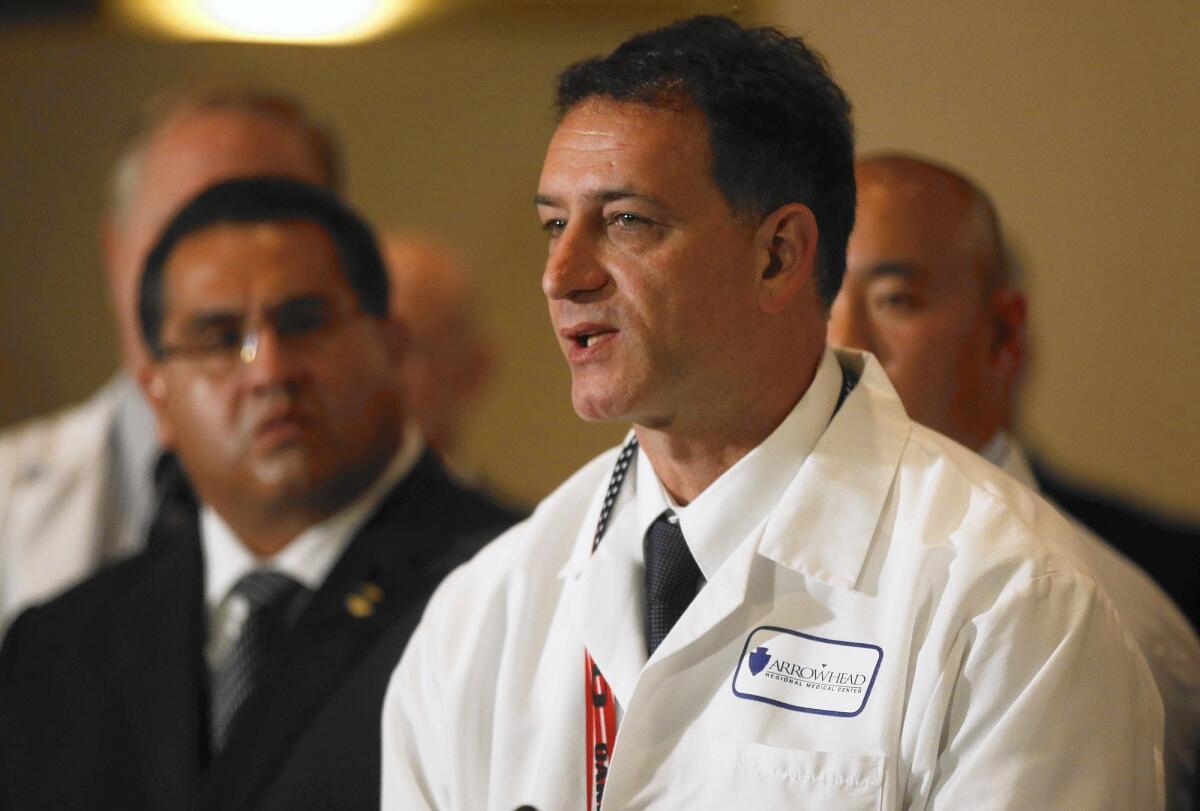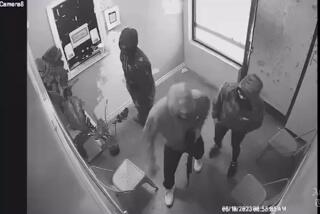After San Bernardino shooting, one doctor seeks ways to turn the ‘golden hour’ of treatment into minutes

Alex Jabourian wrapped up his presentation on neurological disorders with a surprise: a slide showing an image captured by a 13-week ultrasound.
His wife, Nina, like him a resident at Arrowhead Regional Medical Center, was pregnant. Cheers filled the hospital auditorium.
Then a doctor burst in. Someone had opened fire at a building in San Bernardino, he said.
On Day One of their emergency medicine tactical rotation, the Jabourians rushed to the trauma bay on the first floor.
Dr. Michael Neeki, an attending physician at the medical center, ran into the room. Neeki grabbed Alex Jabourian’s shoulder and looked him in the eye.
“Are you coming with me?” Neeki asked. Alex and Nina Jabourian quickly got into Neeki’s SUV.
More than two months later, Neeki is sitting in one of the hospital’s trauma bays. There’s an “SB Strong” button pinned to a lanyard around his neck.
He has been studying the timeline of a terrorist attack that killed 14 people and left 22 wounded.
The mass shooting by Syed Rizwan Farook and his wife, Tashfeen Malik, at the Inland Regional Center caused Neeki to reflect, sometimes with frustration, on whether more lives could have been saved.
Since the Dec. 2 attack, much thought has gone into what could have been done better. San Bernardino police were widely commended for their quick response. But even the department’s chief, Jarrod Burguan, said not everything went smoothly.
Officers told him that among the changes that should be made were improving medical training and supplies, buying more rifles and equipping officers with body armor that protects against rifle fire.
Join the conversation on Facebook >>
Though officers with basic CPR and first aid knowledge carried injured victims out of the building, they did not have specialized medical training, which experts say could provide lifesaving care in chaotic situations.
Neeki focuses on how long it took for patients to get to Arrowhead Regional Medical Center.
“The first patient arrived at the hospital at 11:50,” he said. “It took 50 minutes. Why did it take so long? It’s a five-mile drive.”
Neeki, 51, said he hopes to start a medical program that would increase the number of doctors caring for critically injured patients in a mass-casualty emergency.
The shooting laid bare how much work still needed to be done, Neeki said.
“My goal is to convert the golden hour of trauma to golden minutes and improve survival rates of innocent victims,” he said.
On the day of the mass shooting, the phone never seemed to stop ringing.
As Neeki and the Jabourians drove to the Inland Regional Center, the SWAT team kept calling with updates.
But their SUV was stopped about every 100 feet along the way, Neeki said. Each time, they were asked to show identification. By the time they arrived at the scene about 11:30 a.m., almost half an hour had passed.
“They still thought the shooters were in the building, and they thought there were three,” Nina Jabourian said. “It was a bloody and sad scene.”
Parked at the Inland Regional Center, Neeki handed the two residents a trauma bag filled with emergency medical equipment.
He kept one for himself and grabbed a handgun, just in case.
Neeki, a volunteer doctor with the Inland Valley SWAT team, brought with him military experience from his native Iran.
Over time, he became a hybrid: A physician trained to treat the typical wounds seen in America’s streets and from scenes of war. On the day of the shooting, he was the sixth member of a SWAT team tasked with evacuating county employees from the center.
The Jabourians didn’t know that Neeki would be sweeping the building until officers handed them Kevlar suits and helmets and put them in the back of an armored vehicle.
They wouldn’t see Neeki for the next hour and a half.
The Jabourians learned the intricacies of emergency response on the spot.
“It was chaotic,” Nina Jabourian recalled. “We were a little scared, a little excited.”
“I just hoped that there weren’t going to be any more victims,” she added. “But I was glad we were there because if there were more, we could respond right away.”
The setting was unbelievable, Alex Jabourian said. The most badly wounded people had already been taken away by paramedics, but for moments the couple wondered if they would be treating the critically injured alone.
“We literally had our hands, a trauma bag and that was it,” Alex Jabourian said. “And we were expected to save a life.”
As Neeki and the SWAT team made their way through hallways and offices of the Inland Regional Center, each room posed a threat. Every step uncovered another piece of the horror that had unfolded: A once-festive scene turned into a gallery of death. Family pictures sat on desks surrounded by Christmas decorations and candy.
Walking past the photos, wearing Kevlar and with his equipment on his back, Neeki thought: “All these people have families worried about them.”
The SWAT team pulled 11 people out of an office on the second floor, he said, a look of horror on every face.
“Most of them were nervous, sobbing, having anxiety,” Neeki said. “You had to calm them down.”
He never thought that a terrorist attack would happen in his hometown. During SWAT training, Neeki said, crews practiced dealing with improvised explosives, such as pipe bombs. Still, a bomb in San Bernardino seemed farfetched.
“We would laugh and say, ‘Who the hell is gonna put something like that in the Inland Empire?’” Neeki said.
Only later did he learn that a pipe bomb had been left behind in the conference room where the dead and dying lay. It never went off.
At the scene of the mass killing, first responders and police officers recognized Neeki. They knew that he carried his own weapon and body armor. Alex and Nina Jabourian did not.
“We knew he was in tactical medicine, but we didn’t understand to what degree,” Nina Jabourian said, adding that their time with him in the field was a bonding experience.
In the days after the attack, Neeki told them what happened inside the building, what it looked like, what he saw, the people he encountered.
“He got kind of emotional,” Nina Jabourian said. “They saw dead bodies. You can tell it got to him that he couldn’t get there to help them all out.”
If another attack were to happen, the couple said, they would follow Neeki without hesitation. But this time they would have much-needed experience under their belts.
Twitter: @sarahparvini
MORE ON SAN BERNARDINO
FBI can’t figure out how to unlock encrypted phone in San Bernardino investigation
Trial delayed for Enrique Marquez Jr., accused of supplying 2 guns in San Bernardino attack
San Bernardino police are praised for attack response but know not everything went smoothly
More to Read
Sign up for Essential California
The most important California stories and recommendations in your inbox every morning.
You may occasionally receive promotional content from the Los Angeles Times.











